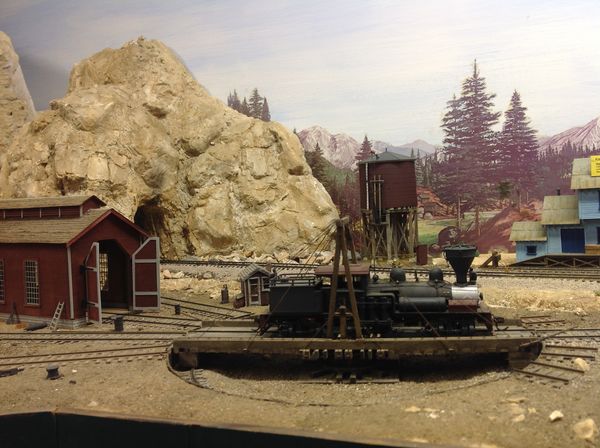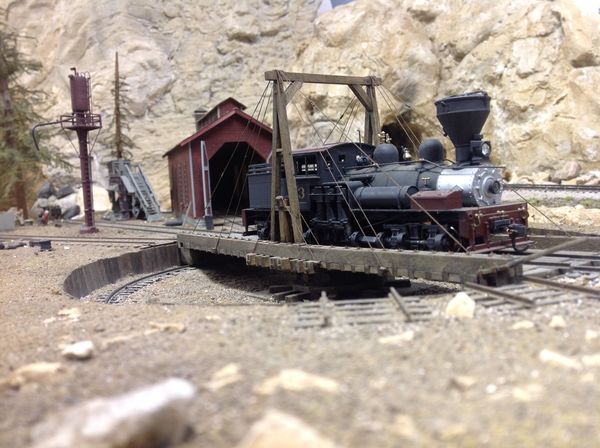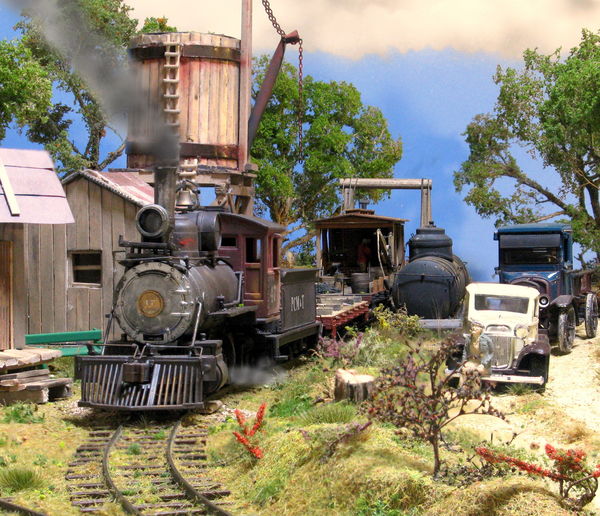Model Railroading Or Diorama Scenes-Are Any UHH's Participating in This Hobby?
May 4, 2020 13:27:10 #
GHS58 wrote:
HO scale. Rock wall built with celotex (sp?) ceiling tile. Broken up and glued up in layers. Covered first with a coat of white latex paint, then tinted with Woodland Senics wash. Top part of wall is plaster of paris in Woodland Senics rubber molds.
Thank You!
Pat
May 4, 2020 15:25:36 #
n4jee
Loc: New Bern, NC
If you decide to go with N scale I have a bunch of stuff that I'll make you a good deal on.
Gene
Gene
May 5, 2020 07:02:53 #
Jay Pat wrote:
Daughter in law gave me her childhood HO train set... (show quote)
I have been interested in trains since that day I was in the hospital at about five years of age (67 years ago!). My bed was against the window. I clambered up to it and watched a freight train steam across the horizon on this side of the Rhine.
At present I have rolling stock in the following scales: Lionel, O, HO, N, and Z (includes one of the first sets sold in the States). Started a N-scale layout that remains in process for the last three decades. (The story is too long and convoluted.)
My experience tells me to advise that anyone wanting to do layouts that they should determine stages to accomplish along the way. And to watch out for the "eyes bigger than the stomach" syndrome! Most important to keep in mind: "It will NEVER be finished!" Other than this, have fun.

May 5, 2020 07:48:42 #
Can't say that we are hobbiests but we do set up the HO set we purchased over 50 years ago for our kids. Done this just about every year since '69. Everyone of our kids, grandkids and now our great grandkids enjoy. Started out on a sheet of plywood but has grown to 16'x8'. Now our boys have decided that they would like to redo the scenery to all snow. and put it on our lanai so they can make it better. But with the current situation I believe it will be 2 years before it gets done. Enjoy your new hobby.
May 5, 2020 08:26:36 #
I've been in the model rr hobby most of my life--from 7 yo till now. I picked up photography partly for shooting live trains and then the models. Since I'm also a full time pro, I shoot layouts for publications. I've also photographed ads for several commercial clients selling trains. It takes much effort to squeeze into tight situations especially when you get into senior era territory. I used to drag a 4X5 camera plus a 6X12 and my 35mm gear plus complete lighting equipment, for major projects. The digital era brought many into covering the models and of course nearly every fan trip brings out thousands of cameras. A good friend once suggested that (at the time) Kodak should sponsor the fan trips as a way of selling film.
May 5, 2020 09:40:33 #
GHS58 wrote:
Great indoor hobby. Lots of ways to use your talents. I have been working on my layout for 50+ years. Not done yet. Always some expansion and more to do.
Nice picture of that engine but no engineer, and it's to clean.... but still very good....
May 5, 2020 09:46:17 #
May 5, 2020 11:20:10 #
Take a look at visitroanokeva.com, Light and Shadow (my moniker but not my work) to see the incredible Steamers Point layout with wonderful photography by Jimmy Deck to see a marvelous blending of art in railroad modeling (really a city scape with a railroad) and photography. Let me know what you think when you see it.
May 5, 2020 12:58:11 #
Rondog
Loc: Western Mass
I am not into trains, my hobby is new interest in photography from old and 30 to 40 years in RC air planes ,helicopters and drones,, way too far into this, has taken over the house, great fun
May 5, 2020 13:10:43 #
badapple
Loc: Twin Lake, Michigan
Pat, model railroading is another of my hobbies. Seldom post so hope these pics from my iPad show up. The shay (engine) is kit built as is the turntable. The engine house is scratch built and the mountain is made with plaster. Be glad to answer any questions you may have.
Burt Apple
Burt Apple


May 5, 2020 13:23:39 #
badapple wrote:
Pat, model railroading is another of my hobbies. Seldom post so hope these pics from my iPad show up. The shay (engine) is kit built as is the turntable. The engine house is scratch built and the mountain is made with plaster. Be glad to answer any questions you may have.
Burt Apple
Burt Apple
Great job all around.


May 5, 2020 13:38:09 #
I would certainly take him up on the free books, BUT there have been drastic improvements and complexity in parts of model railroading. So some of the info in older books is outdated as written below.
The following applies only if you want to run trains. For a static diorama, you can ignore the following. Newer equipment is generally much better. Locos run better, and plastic models are terrific now, where brass used to be much better (better details, but much more expensive). Now plastic is just as good, while brass often does not run well--it looks good, but may not run well.
The biggest improvement is in the power. The standard is now DCC (Digital Command and Control). Google for details, but simply put, DCC allows you to control the locomotive instead of controlling the track. The original DC (direct current) powered the track, and the loco(s) on that section of track all did the same thing with a track power change--all ran the same speeds (neglecting minor performance differences), ran the same direction, and it was entirely up to you as the operator to slowly increase or decrease speeds so the locos movements seemed realistic.
DCC requires a tiny computer inside each device (usually locos, although many other devices may be DCC equipped). This "decoder" reads the DCC pulsed power it picks up from the track, but only responds to a "word" at the beginning of a segment of power. That coded word is the address of the loco, and it is sent by the hand held controller which was preset to the loco's address. If the decoder detects another address (from another controller), it ignores the instruction that follows (speed up/slow down, start/stop, reverse direction, etc.) and it continues to move or stay stopped as if the instruction was never sent--indeed it was never received. This means that the operator's portable controller (similar to a TV remote) controls only the loco it is set to control. This makes the train (loco) independent of the track (except as a source of power), that is, dependent upon only the commands addressed to it. Thus, two or more trains on the same electrical section of track can change their movements independent of each other.
DCC is great, and absolutely necessary for a fine contemporary model RR that is built to run trains, even if just for occasional running. But it adds greatly to the cost, and to the complexity of setting up a loco (speed adjustment to match other locos so they may be consisted together), but it adds sounds such as bell, whistle, steam chugging and hissing, diesel sounds, whistles or horns, rail/wheel squeaks, automatically increase/decrease the speed for realism, and more. Each loco requires a $100+ decoder, and the controllers and power supply and control units are a few hundred more. The track is still divided into electrical blocks, but not for DC control, but for DCC convenience; a short (like a derailment) within a block will effect all locos within the block, so you want multiple blocks pretty soon as the railroad grows--so one derailment does not shut down the whole layout, but just that one block. And each block requires a circuit breaker to protect the locos within that block--more expense.
A separate need for multiple blocks for DCC is that the voltage to the track is a bipolar alternating current (AC) square wave signal. A separate "command station" quickly switches the direction of the DC voltage and adds the address for each command (a "command" meaning each change of a hand held controller, or throttle). This varying DC results in a modulated pulse wave. The frequency is about 17.5kHz, and this limits the distance the signal can be effectively be sent along the wiring plus track to 50 or 60 feet. Only a single command station is needed for the whole layout, but a "booster" (the power supply) is needed for each of these electrical blocks. Thus beyond each 50 feet or so (100 feet counting both directions if the booster is centered), another booster (more $) is required for a new electrically isolated electrical block. So separate electrical blocks are required, just as with a DC powered model.
A real advantage of DCC is the simplicity of the original wiring compared to DC, strange as that seems.
You have a good chance of damaging a DCC decoder ($100+) running it on DC. You can install a DCC decoder in most locos or their tenders if there is room in it, and if you can non-destructively get the shell off to get inside it.
So the books you receive may be old enough not to cover these advances, but all topics but DCC will be useful.
Verryl
http://www.wyomingdivision.org/
The following applies only if you want to run trains. For a static diorama, you can ignore the following. Newer equipment is generally much better. Locos run better, and plastic models are terrific now, where brass used to be much better (better details, but much more expensive). Now plastic is just as good, while brass often does not run well--it looks good, but may not run well.
The biggest improvement is in the power. The standard is now DCC (Digital Command and Control). Google for details, but simply put, DCC allows you to control the locomotive instead of controlling the track. The original DC (direct current) powered the track, and the loco(s) on that section of track all did the same thing with a track power change--all ran the same speeds (neglecting minor performance differences), ran the same direction, and it was entirely up to you as the operator to slowly increase or decrease speeds so the locos movements seemed realistic.
DCC requires a tiny computer inside each device (usually locos, although many other devices may be DCC equipped). This "decoder" reads the DCC pulsed power it picks up from the track, but only responds to a "word" at the beginning of a segment of power. That coded word is the address of the loco, and it is sent by the hand held controller which was preset to the loco's address. If the decoder detects another address (from another controller), it ignores the instruction that follows (speed up/slow down, start/stop, reverse direction, etc.) and it continues to move or stay stopped as if the instruction was never sent--indeed it was never received. This means that the operator's portable controller (similar to a TV remote) controls only the loco it is set to control. This makes the train (loco) independent of the track (except as a source of power), that is, dependent upon only the commands addressed to it. Thus, two or more trains on the same electrical section of track can change their movements independent of each other.
DCC is great, and absolutely necessary for a fine contemporary model RR that is built to run trains, even if just for occasional running. But it adds greatly to the cost, and to the complexity of setting up a loco (speed adjustment to match other locos so they may be consisted together), but it adds sounds such as bell, whistle, steam chugging and hissing, diesel sounds, whistles or horns, rail/wheel squeaks, automatically increase/decrease the speed for realism, and more. Each loco requires a $100+ decoder, and the controllers and power supply and control units are a few hundred more. The track is still divided into electrical blocks, but not for DC control, but for DCC convenience; a short (like a derailment) within a block will effect all locos within the block, so you want multiple blocks pretty soon as the railroad grows--so one derailment does not shut down the whole layout, but just that one block. And each block requires a circuit breaker to protect the locos within that block--more expense.
A separate need for multiple blocks for DCC is that the voltage to the track is a bipolar alternating current (AC) square wave signal. A separate "command station" quickly switches the direction of the DC voltage and adds the address for each command (a "command" meaning each change of a hand held controller, or throttle). This varying DC results in a modulated pulse wave. The frequency is about 17.5kHz, and this limits the distance the signal can be effectively be sent along the wiring plus track to 50 or 60 feet. Only a single command station is needed for the whole layout, but a "booster" (the power supply) is needed for each of these electrical blocks. Thus beyond each 50 feet or so (100 feet counting both directions if the booster is centered), another booster (more $) is required for a new electrically isolated electrical block. So separate electrical blocks are required, just as with a DC powered model.
A real advantage of DCC is the simplicity of the original wiring compared to DC, strange as that seems.
You have a good chance of damaging a DCC decoder ($100+) running it on DC. You can install a DCC decoder in most locos or their tenders if there is room in it, and if you can non-destructively get the shell off to get inside it.
So the books you receive may be old enough not to cover these advances, but all topics but DCC will be useful.
Verryl
http://www.wyomingdivision.org/
May 5, 2020 14:53:50 #
May 5, 2020 15:01:18 #
badapple wrote:
Pat, model railroading is another of my hobbies. Seldom post so hope these pics from my iPad show up. The shay (engine) is kit built as is the turntable. The engine house is scratch built and the mountain is made with plaster. Be glad to answer any questions you may have.
Burt Apple
Burt Apple
Really enjoyed these images!!!
I've seen at least two of these manual turntables.
One is at the Nevada State Railroad Museum and the other one is just inside the west part of Yosemite NP in the community of El Portal on Hwy 140 (there is also a Shay locomotive there).
I call this turntable a "kit". It has a few metal parts and rest is locally milled timber from back in the day.
Pat
May 5, 2020 15:04:56 #
lightandshadowjourney wrote:
Take a look at visitroanokeva.com, Light and Shadow (my moniker but not my work) to see the incredible Steamers Point layout with wonderful photography by Jimmy Deck to see a marvelous blending of art in railroad modeling (really a city scape with a railroad) and photography. Let me know what you think when you see it.
I saw some "night" images. Well captured!!!
Pat
If you want to reply, then register here. Registration is free and your account is created instantly, so you can post right away.





